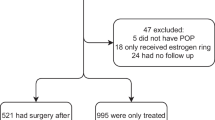Abstract
Introduction and hypothesis
We aimed to identify factors contributing to successful pessary use for over 1 year.
Methods
A chart review was conducted composed of 150 women at Montefiore Medical Center, using a pessary for over 1 year. Characteristics of those who continued pessary usage were compared with those who discontinued use by using Chi-square, Fisher’s exact test, logistic regression model, receiver–operator characteristic curve, and Kaplan–Meier survival curves.
Results
Thirty-five women (23%) discontinued using pessaries (DP) after a year, while 115 women (77%) continued (CP). There was no difference in multiple characteristics. The DP group had more patients with stress incontinence, p = 0.17. Older age at pessary insertion showed higher continued use (OR = 1.083, CI: 1.033–1.136). Patients with a history of prolapse repair surgery were more likely to discontinue pessary use.
Conclusions
Age greater than 72 years was associated with continued pessary use and history of hysterectomy or prolapse surgery, and stress incontinence were associated with discontinuation.


Similar content being viewed by others
References
Subak LL, Waetjen LE, Van den Eaden S, Thom DH, Vittinghoff E, Brown JS (2001) Cost of pelvic organ prolapse surgery in the United States. Obstet Gynecol 98:646–651
Olsen AL, Smith VJ, Bergstrom JO, Colling JC, Clark AL (1997) Epidemiology of surgically managed pelvic organ prolapse and urinary incontinence. Obstet Gynecol 89:501–506
Clemons JL, Aguilar VC, Tillinghast TA, Jackson ND, Myers DL (2004) Risk factors associated with an unsuccessful pessary fitting trial in women with pelvic organ prolapse. Obstet Gynecol 190:345–350
Mutone MF, Terry C, Hale DS, Benson JT (2005) Factors which influence the short-term success of pessary management of pelvic organ prolapse. Obstet Gynecol 193:89–94
Hanson LA, Schulz JA, Flood CG, Cooley B, Tam F (2006) Vaginal pessaries in managing women with pelvic organ prolapse and urinary incontinence: patient characteristics and factors contributing to success. Int Urogynecol J 17:155–159
Maito JM, Quam ZA, Craig E, Danner KA, Rogers RG (2006) Predictors of successful pessary fitting and continued use in a nurse–midwifery pessary clinic. J Midwifery Women’s Health 51:78–84
Powers K, Lazarou G, Wang A, LaCombe J, Bensinger G, Greston WM et al (2006) Pessary use in advanced pelvic organ prolapse. Int Urogynecol J 17:160–164
Heit M, Rosenquist C, Culligan P, Graham C, Murphy M, Shott S (2003) Predicting treatment choice for patients with pelvic organ prolapse. Obstet Gynecol 101:1279–1284
Clemons JL, Aguilar VC, Sokol ER, Jackson ND, Myers DL (2004) Patient characteristics that are associated with continued pessary use versus surgery after 1 year. Obstet Gynecol 191:159–164
Brincat C, Kenton K, Fitzgerald MP, Brubaker L (2004) Sexual activity predicts continued pessary use. Obstet Gynecol 191:198–200
Conflicts of interest
None.
Author information
Authors and Affiliations
Corresponding author
Rights and permissions
About this article
Cite this article
Friedman, S., Sandhu, K.S., Wang, C. et al. Factors influencing long-term pessary use. Int Urogynecol J 21, 673–678 (2010). https://doi.org/10.1007/s00192-009-1080-x
Received:
Accepted:
Published:
Issue Date:
DOI: https://doi.org/10.1007/s00192-009-1080-x




